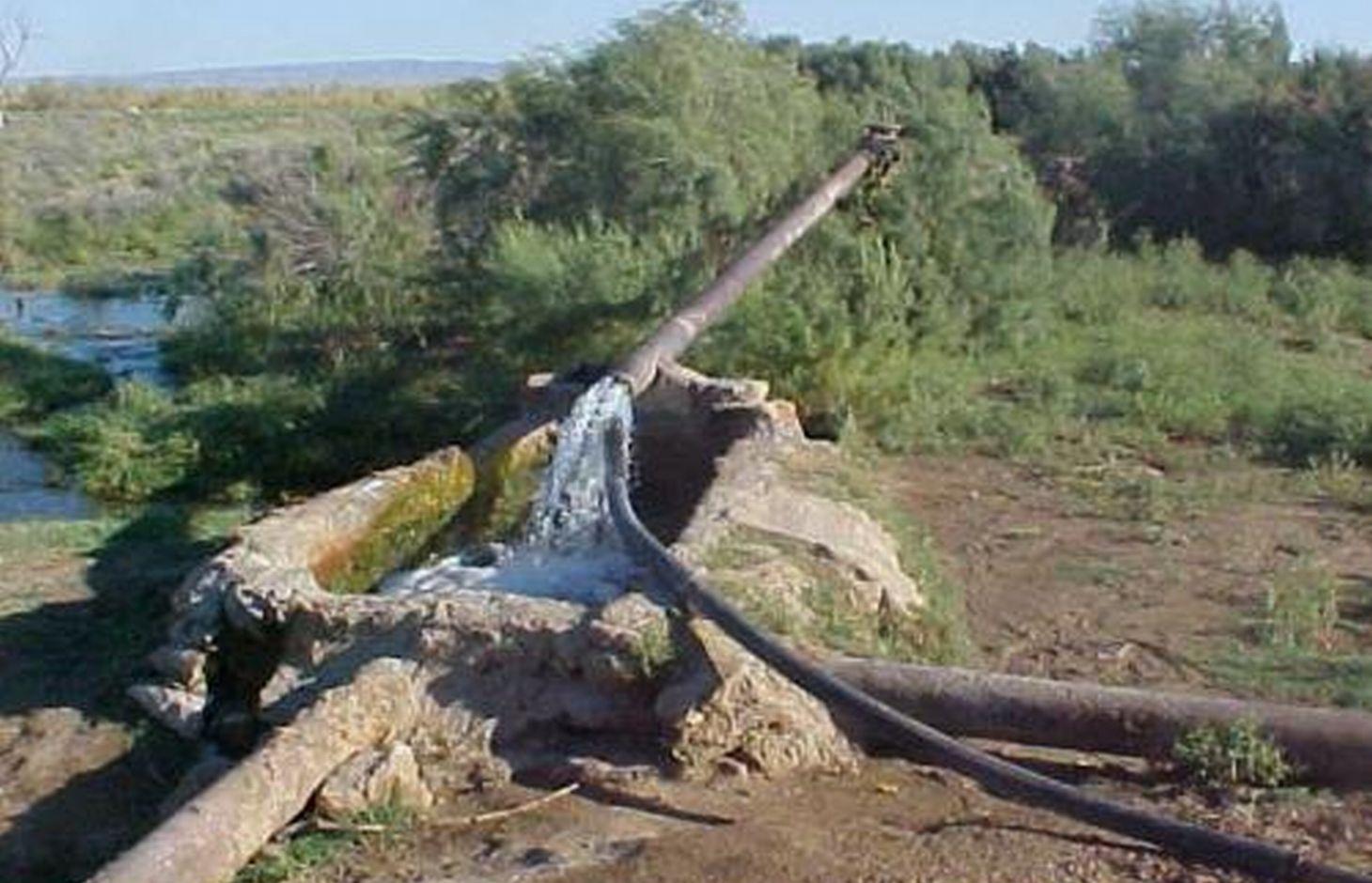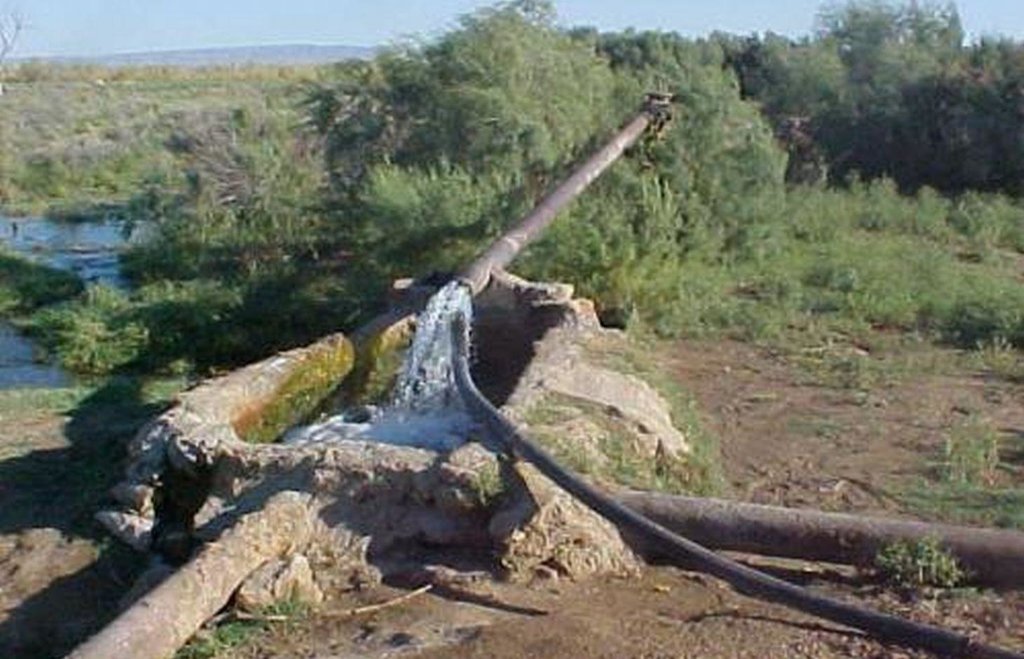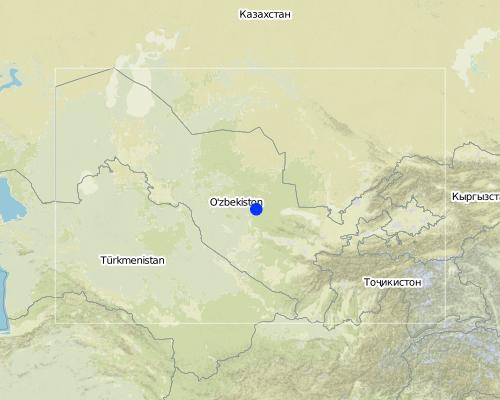Использование артезианских минерализованных вод для организации поливного земледелия в Кызылкумах (ИСЦАУЗР) [Uzbekistan]
- Creation:
- Update:
- Compiler: Rustam Ibragimov
- Editor: –
- Reviewer: David Streiff
Инициатива Стран Центральной Азии по Управлению Земельными Ресурсами (ИСЦАУЗР)
technologies_1117 - Uzbekistan
- Full summary as PDF
- Full summary as PDF for print
- Full summary in the browser
- Full summary (unformatted)
- Использование артезианских минерализованных вод для организации поливного земледелия в Кызылкумах (ИСЦАУЗР): April 28, 2017 (inactive)
- Использование артезианских минерализованных вод для организации поливного земледелия в Кызылкумах (ИСЦАУЗР): Aug. 1, 2017 (inactive)
- Использование артезианских минерализованных вод для организации поливного земледелия в Кызылкумах (ИСЦАУЗР): Aug. 2, 2017 (inactive)
- Использование артезианских минерализованных вод для организации поливного земледелия в Кызылкумах (ИСЦАУЗР): Aug. 22, 2019 (public)
View sections
Expand all Collapse all1. General information
1.2 Contact details of resource persons and institutions involved in the assessment and documentation of the Technology
SLM specialist:
Uzbekistan
SLM specialist:
Uzbekistan
Name of the institution(s) which facilitated the documentation/ evaluation of the Technology (if relevant)
Central Asian Countries Initiative for Sustainable Land Management - Multicountry Capacity Building (CACILM - MCB) - KyrgyzstanName of the institution(s) which facilitated the documentation/ evaluation of the Technology (if relevant)
Research Institute of Karakul Breeding and Desert Ecology of Uzbekistan - Uzbekistan1.3 Conditions regarding the use of data documented through WOCAT
When were the data compiled (in the field)?
15/09/2011
The compiler and key resource person(s) accept the conditions regarding the use of data documented through WOCAT:
Ja
2. Description of the SLM Technology
2.1 Short description of the Technology
Definition of the Technology:
Выращивание кормовых и ряда продовольственных культур в пустыне Кызылкум на базе орошения минерализованной водой из самоизливающейся артезианской скважины
2.2 Detailed description of the Technology
Description:
Пастбищное животноводство является важной составной частью аграрного сектора Узбекистана, в котором производится более 60% всей животноводческой продукции. Сконцентрированное на площади 17,5 млн. га, оно основывается на полном или частичном содержании скота на пастбищах. При средней урожайности пастбищ 1,7 ц/га обеспеченность кормами составляет весной 80%, в летне-осенний период -100% и зимой - 60-65%. Общий дефицит кормов в пустыне Кызылкум около 540 тыс. тонн (15% от общей потребности). В этой связи производство страхового запаса кормов является актуальной задачей.
В пустыне Кызылкум имеются артезианские скважины с дебетом 13-15 л/с каждая. Вода из скважин имеет нейтральную кислотную реакцию (PH- 7,4) и среднее засоление (Ec= 5,6-8,3 ds/м). На базе орошения водой из этих скважин внедрена технология выращивания солеустойчивых культур и галофитов в качестве корма скоту. Учитывая минерализацию поливной воды и качество галофитов, определена пригодность этих кормов для различных групп скота и разработана система подготовки их к скармливанию животными. (в рамках ИСЦАУЗР)
Purpose of the Technology: Улучшение земель, сохранение верхнего слоя почвы, восстановление растительного покрова, предупреждение перевыпаса и снижение нагрузки на пастбища путем организации орошаемого кормопроизводства.
Establishment / maintenance activities and inputs: Технологические процессы по организации поливного земледелия являются традиционными и включают планировку земли, вспашку, чилелевание, боронование, посев, нарезку поливных борозд и уход за посевами. Протестированы следующие виды кормовых культур: озимые зерновые - ячмень «Мовлоно», рожь «Киргизская -1», тритикале «Праг серебристый», пшеница «Крошка»; кормовые культуры - кукуруза «Белозубая», африканское просо «Aip-13150», сорго «Ок жухори» и «Веничное», суданская трава; люцерна - «Ташкентская», «Eureca», «D-1», «D-2», солодка голая и кормовые галофиты - кохия веничная К. scoparia (L.) Schrad, бассия иссополистная Bassia hyssopifolia (Pallas) O. Kuntze, сведа высокая S. altissima, и климакоптера шерстистая Climacoptera lanata.
Natural / human environment: Использование минерализованных вод на орошение возможно только на легких по механическому составу пустынных почвах, а внедрение в севооборот галофитов, которые выносят до 40% солей из почвы, является обязательным условием экологической приемлемости использования соленых вод. Население, проживающее в Кызылкумах, традиционно занимается животноводством, которое является основным средством существования и выполняет своеобразную функцию накопления семейных сбережений. В целях повышения доходов население увеличивает поголовье, не учитывая площадь и состояние пастбищ. Бессистемный выпас и превышение нормативной нагрузки на пастбища создает угрозу биоразнообразию. Организация кормопроизводства создаст кормозапасы и снизит нагрузку на пастбища. В Канимехском районе имеется 63 артезианских скважины, на базе которых можно организовать поливное земледелие на площади 350-400 га. В пустыне Кызылкум данную технологию можно внедрить на площади 25 000 га. Технология позволяет получать с каждого гектара 3-5 тонн соломы и 1,5-2,0 тонн зерна озимой пшеницы, 48-78 тонн силосной массы кукурузы, сорго и проса, 144-150 ц/га сена люцерны, 23 т/га сена надземной фитомассы солодки, галофиты производят 5,0-10,0 тонн/га сена. Чистый доход от поливного земледелия на минерализованных артезианских водах в Кызылкумах составляет 1,5 млн. сумм/га
2.3 Photos of the Technology
2.5 Country/ region/ locations where the Technology has been applied and which are covered by this assessment
Country:
Uzbekistan
Region/ State/ Province:
Узбекистан
Further specification of location:
Навоийская область/ Канимехский район
Map
×2.6 Date of implementation
If precise year is not known, indicate approximate date:
- less than 10 years ago (recently)
2.7 Introduction of the Technology
Specify how the Technology was introduced:
- during experiments/ research
- through projects/ external interventions
Comments (type of project, etc.):
Эксперименты и исследования по использованию минерализованных артезианских вод на полив кормовых культур разработана учеными Узбекистана 40 лет назад.Внедрена технология в рамках Проекта ИКАРДА «Исследования по устойчивому управлению земельными ресурсами» Эксперимент 4 и 5 «Зона реабилитации пастбищных угодий» в 2007-2009г.г.
3. Classification of the SLM Technology
3.1 Main purpose(s) of the Technology
- reduce, prevent, restore land degradation
3.2 Current land use type(s) where the Technology is applied

Grazing land
Extensive grazing land:
- Semi-nomadism/ pastoralism
Comments:
Major land use problems (compiler’s opinion): Низкий уровень естественного плодородия пустынных почв и крайне засушливые условия (мало осадков, низкая влажность воздуха и высокие летние температуры)
Major land use problems (land users’ perception): почвы плохого качества и сухой климат
Semi-nomadism / pastoralism: скотоводческое хозяйство, преобладает мелкий рогатый скот
Future (final) land use (after implementation of SLM Technology): Grazing land: Gi: Intensive grazing/ fodder production
If land use has changed due to the implementation of the Technology, indicate land use before implementation of the Technology:
Grazing land: Ge: Extensive grazing land
3.3 Further information about land use
Water supply for the land on which the Technology is applied:
- rainfed
Number of growing seasons per year:
- 1
Specify:
Longest growing period in days: 220
Longest growing period from month to month: апрель-ноябрь
Livestock density (if relevant):
10-25 УГ/км2
3.4 SLM group to which the Technology belongs
- improved ground/ vegetation cover
- irrigation management (incl. water supply, drainage)
3.5 Spread of the Technology
Specify the spread of the Technology:
- applied at specific points/ concentrated on a small area
Comments:
Total area covered by the SLM Technology is 0,03 m2.
Пастбище со скудной травянистой пустынной растительностью в пустыне Кызылкум вблизи самоизливающейся артезианской скважины с минерализованной водой. Почвенный покров представлен песчаными почвами с высокой водопроницаемостью.
3.6 SLM measures comprising the Technology

agronomic measures
- A1: Vegetation/ soil cover

management measures
- M1: Change of land use type
Comments:
Main measures: agronomic measures, management measures
Type of agronomic measures: сменное возделывание культур, минеральные (неорганические) удобрения, борозды (дренаж, ирригация)
3.7 Main types of land degradation addressed by the Technology

soil erosion by water
- Wt: loss of topsoil/ surface erosion

biological degradation
- Bc: reduction of vegetation cover
Comments:
Main type of degradation addressed: Бр (Bc): уменьшение растительного покрова
Secondary types of degradation addressed: Вв (Wt): потеря верхнего слоя почвы / поверхностная эрозия
Main causes of degradation: чрезмерный выпас (бессистемный выпас скота и превышение нагрузки на пастбища), засуха (низкое количество осадков, бедный естественный растительный покров)
3.8 Prevention, reduction, or restoration of land degradation
Specify the goal of the Technology with regard to land degradation:
- prevent land degradation
Comments:
Main goals: prevention of land degradation
4. Technical specifications, implementation activities, inputs, and costs
4.1 Technical drawing of the Technology
4.2 Technical specifications/ explanations of technical drawing
Вода из самоизливающейся скважины подается самотеком по арыку или сборному полиэтиленовому лотку, из которого распределяется по поливным бороздам
Location: ширкатное хозяйство «Маданият». Канимехский район/ Навоийская область
Date: 10-10-2011
Technical knowledge required for field staff / advisors: средний
Technical knowledge required for land users: средний
Main technical functions: улучшение земляного покрова, повышение органического вещества, повышение наличия питательных веществ (снабжение, переработка отходов,...), содействие росту видов и сортов растительности (качество, например поедаемые кормовые культуры), повышение плодородия почв
Relay cropping
Material/ species: галофиты и люцерна
Quantity/ density: каждые 4 г
Remarks: 20кг/га (люцерна) и 10-12 кг/га (галофиты)
Mineral (inorganic) fertilizers
Material/ species: карбамид
Quantity/ density: 100 кг/га
Furrows (drainage, irrigation)
Material/ species: поливные ок-арыки
Quantity/ density: 100 м/га
Change of land use type: пастбища стали орошаемой пашней
4.3 General information regarding the calculation of inputs and costs
Specify currency used for cost calculations:
- US Dollars
other/ national currency (specify):
Узбекский сум
Indicate average wage cost of hired labour per day:
10.00
4.5 Costs and inputs needed for establishment
| Specify input | Unit | Quantity | Costs per Unit | Total costs per input | % of costs borne by land users | |
|---|---|---|---|---|---|---|
| Equipment | None | None | 50.0 | 18.2 | 910.0 | |
| Total costs for establishment of the Technology | 910.0 | |||||
Comments:
Duration of establishment phase: 3 month(s)
4.6 Maintenance/ recurrent activities
| Activity | Type of measure | Timing/ frequency | |
|---|---|---|---|
| 1. | Планировка, вспашка, малование, нарезка поливных борозд | Agronomic | осень |
| 2. | Посев | Agronomic | Март-апрель |
| 3. | Уход за посевами (поливы) | Agronomic | Апрель-октябрь |
| 4. | Укосы | Agronomic | Июнь, июль, август |
| 5. | Охрана участка | Management | В течение года |
4.7 Costs and inputs needed for maintenance/ recurrent activities (per year)
| Specify input | Unit | Quantity | Costs per Unit | Total costs per input | % of costs borne by land users | |
|---|---|---|---|---|---|---|
| Labour | None | None | 6.0 | 20.33 | 121.98 | 100.0 |
| Labour | None | None | 1.5 | 9.8 | 14.7 | 100.0 |
| Labour | None | None | 4.0 | 244.75 | 979.0 | 100.0 |
| Labour | None | None | 2.0 | 17.5 | 35.0 | 100.0 |
| Plant material | None | None | 20.0 | 3.495 | 69.9 | |
| Fertilizers and biocides | None | None | 100.0 | 0.266 | 26.6 | 100.0 |
| Other | None | None | 12.0 | 70.0 | 840.0 | 100.0 |
| Total costs for maintenance of the Technology | 2087.18 | |||||
Comments:
Machinery/ tools: Трактор, длиннобазовый планировщик, плуг, борона, мала, с/х техника КПП 2,8 или косилка
Стоимость подсчитана на 1 га (на уровень 2009г.).
4.8 Most important factors affecting the costs
Describe the most determinate factors affecting the costs:
Использование полиэтиленовых лотков для проведения ярусного полива не является обязательным элементом технологии. В целом, технология очень дешевая. Наибольшие затраты относятся к наемному труду по уходу за посевами в течение вегетации.
5. Natural and human environment
5.1 Climate
Annual rainfall
- < 250 mm
- 251-500 mm
- 501-750 mm
- 751-1,000 mm
- 1,001-1,500 mm
- 1,501-2,000 mm
- 2,001-3,000 mm
- 3,001-4,000 mm
- > 4,000 mm
Agro-climatic zone
- semi-arid
Thermal climate class: temperate. 3 месяца t возд <5°С и 7 мес. – выше 10°С
5.2 Topography
Slopes on average:
- flat (0-2%)
- gentle (3-5%)
- moderate (6-10%)
- rolling (11-15%)
- hilly (16-30%)
- steep (31-60%)
- very steep (>60%)
Landforms:
- plateau/plains
- ridges
- mountain slopes
- hill slopes
- footslopes
- valley floors
Altitudinal zone:
- 0-100 m a.s.l.
- 101-500 m a.s.l.
- 501-1,000 m a.s.l.
- 1,001-1,500 m a.s.l.
- 1,501-2,000 m a.s.l.
- 2,001-2,500 m a.s.l.
- 2,501-3,000 m a.s.l.
- 3,001-4,000 m a.s.l.
- > 4,000 m a.s.l.
5.3 Soils
Soil depth on average:
- very shallow (0-20 cm)
- shallow (21-50 cm)
- moderately deep (51-80 cm)
- deep (81-120 cm)
- very deep (> 120 cm)
Soil texture (topsoil):
- coarse/ light (sandy)
Topsoil organic matter:
- low (<1%)
5.4 Water availability and quality
Ground water table:
5-50 m
Availability of surface water:
medium
Water quality (untreated):
for agricultural use only (irrigation)
5.5 Biodiversity
Species diversity:
- low
5.6 Characteristics of land users applying the Technology
Market orientation of production system:
- mixed (subsistence/ commercial
Off-farm income:
- less than 10% of all income
Individuals or groups:
- cooperative
Gender:
- men
Indicate other relevant characteristics of the land users:
Land users applying the Technology are mainly common / average land users
Population density: < 10 persons/km2
Annual population growth: 1% - 2%
5.7 Average area of land owned or leased by land users applying the Technology
- < 0.5 ha
- 0.5-1 ha
- 1-2 ha
- 2-5 ha
- 5-15 ha
- 15-50 ha
- 50-100 ha
- 100-500 ha
- 500-1,000 ha
- 1,000-10,000 ha
- > 10,000 ha
Is this considered small-, medium- or large-scale (referring to local context)?
- medium-scale
5.8 Land ownership, land use rights, and water use rights
Land ownership:
- state
Land use rights:
- leased
Comments:
Ширкатам (крупным с/х кооперативам) государственная земля предоставляется в постоянное владение, которая закрепляется на условиях аренды за членами ширката
5.9 Access to services and infrastructure
health:
- poor
- moderate
- good
education:
- poor
- moderate
- good
technical assistance:
- poor
- moderate
- good
employment (e.g. off-farm):
- poor
- moderate
- good
markets:
- poor
- moderate
- good
energy:
- poor
- moderate
- good
roads and transport:
- poor
- moderate
- good
drinking water and sanitation:
- poor
- moderate
- good
financial services:
- poor
- moderate
- good
6. Impacts and concluding statements
6.1 On-site impacts the Technology has shown
Socio-economic impacts
Production
fodder production
animal production
Income and costs
farm income
Socio-cultural impacts
food security/ self-sufficiency
health situation
Ecological impacts
Soil
soil moisture
soil loss
nutrient cycling/ recharge
salinity
soil organic matter/ below ground C
Biodiversity: vegetation, animals
biomass/ above ground C
6.3 Exposure and sensitivity of the Technology to gradual climate change and climate-related extremes/ disasters (as perceived by land users)
Gradual climate change
Gradual climate change
| Season | Type of climatic change/ extreme | How does the Technology cope with it? | |
|---|---|---|---|
| annual temperature | increase | well |
Climate-related extremes (disasters)
Meteorological disasters
| How does the Technology cope with it? | |
|---|---|
| local rainstorm | well |
| local windstorm | well |
Climatological disasters
| How does the Technology cope with it? | |
|---|---|
| drought | well |
Hydrological disasters
| How does the Technology cope with it? | |
|---|---|
| general (river) flood | not well |
Other climate-related consequences
Other climate-related consequences
| How does the Technology cope with it? | |
|---|---|
| reduced growing period | well |
Comments:
Технология устойчива ко многим климатическим перепадам, так как базируется на самоизливающихся скважинах, которые являются гарантированным источником водных ресурсов, а выращиваемые культуры биологически приспособлены к неблагоприятным условиям пустыни (суховеям, засухам, высоким температурам и др.).
6.4 Cost-benefit analysis
How do the benefits compare with the establishment costs (from land users’ perspective)?
Short-term returns:
very positive
Long-term returns:
very positive
How do the benefits compare with the maintenance/ recurrent costs (from land users' perspective)?
Short-term returns:
positive
Long-term returns:
very positive
Comments:
Краткосрочные: производство кормов, овощных и бахчевых культур, обеспечение полноценным кормом скота в осенне-зимний период и населения продуктами питания
Долгосрочные: сохранение и повышение биоразнообразия, снижение нагрузки на пастбища.
6.5 Adoption of the Technology
- more than 50%
Of all those who have adopted the Technology, how many have did so spontaneously, i.e. without receiving any material incentives/ payments?
- 0-10%
Comments:
100% of land user families have adopted the Technology with external material support
20 land user families have adopted the Technology with external material support
There is no trend towards spontaneous adoption of the Technology
Comments on adoption trend: вследствие отсутствия культуры земледелия у местного населения, традиционно занимающегося скотоводством
6.7 Strengths/ advantages/ opportunities of the Technology
| Strengths/ advantages/ opportunities in the land user’s view |
|---|
| Быстрое получение высоких доходов и низкий уровень вложений в технологию |
| Strengths/ advantages/ opportunities in the compiler’s or other key resource person’s view |
|---|
|
Не требует специальных вложений во внедрение технологии How can they be sustained / enhanced? постоянно |
|
Быстрое получение высоких доходов; с каждого гектара имеется до 1,5 млн. сум чистого дохода How can they be sustained / enhanced? постоянно |
|
Используются имеющиеся местные ресурсы и материалы How can they be sustained / enhanced? постоянно |
|
Наличие гарантированного источника воды для орошения обеспечивает стабильность производства How can they be sustained / enhanced? постоянно |
|
Создает рабочие места и повышает занятость и рост производства How can they be sustained / enhanced? постоянно |
6.8 Weaknesses/ disadvantages/ risks of the Technology and ways of overcoming them
| Weaknesses/ disadvantages/ risks in the land user’s view | How can they be overcome? |
|---|---|
| Отсутствие техники и традиций земледелия |
| Weaknesses/ disadvantages/ risks in the compiler’s or other key resource person’s view | How can they be overcome? |
|---|---|
| Отсутствие с/х техники у местных землепользователей, занимающихся скоторазведением | Обучение, пропаганда |
| Отсутствие опыта и культуры земледелия среди местного населения, традиционно являющегося скотоводством | |
Links and modules
Expand all Collapse allLinks
No links
Modules
No modules






